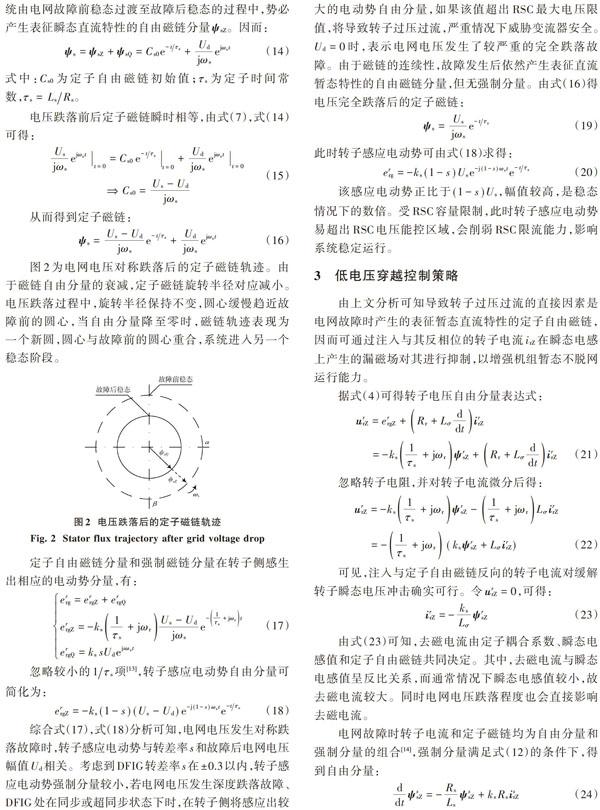双馈风电机组去磁控制策略研究
毛剑波 吴国祥
摘 要: 大规模风电接入对电力系统影响巨大,低电压穿越(LVRT)能力成为全球电网公司针对风电并网制定的硬性指标。根据该指标对对称电网故障工况下双馈感应电机(DFIG)电磁瞬态过程进行深入分析,研究一种基于去磁控制机理的低电压穿越控制策略。在转子侧注入与定子自由磁链方向相反的去磁电流,能有效抑制磁链过渡分量、减小转子感应电动势、提升DFIG低电压穿越能力。利用Matlab/Simulink平台进行仿真,结果证明该控制策略能扼制瞬态电压冲击,协助系统迅速恢复,且控制结构简单、灵活性高。
关键词: 低电压穿越; 对称故障; 双馈感应电机; 电磁瞬态过程; 去磁控制; 系统恢复
中图分类号: TN03?34; TM614 文献标识码: A 文章编号: 1004?373X(2018)17?0102?05
Abstract: Since the large?scale wind power integration has a great influence on the electric power system, the ability of low voltage ride through (LVRT) becomes an obligatory index of global grid corporations for wind power integration. According to the index, the electromagnetic transient process of the doubly?fed induction generator (DFIG) under the condition of symmetrical grid fault is analyzed deeply, and an LVRT control strategy based on demagnetization control mechanism is studied. The demagnetization current opposite to the stator freedom flux linkage direction is injected into the rotor side to effectively restrain the transient component of the flux linkage, decrease the induced electromotive force of the rotor, and improve the LVRT ability of DFIG. The strategy is simulated with Matlab/Simulink. The simulation results demonstrate that the control strategy can suppress the transient voltage surge, assist the system recovery rapidly, and has simple structure and high flexibility.
Keywords: low voltage ride through; symmetrical grid fault; DFIG; electromagnetic transient process; demagnetization control; system recovery
0 引 言
風能清洁环保、发展前景优良,是开发最具规模的新型能源之一。随着风电渗透率的不断攀升,机组与电网的互扰问题[1]备受瞩目。为避免电网故障导致机组大范围脱网,新的并网技术规程明确提出电网电压跌落时风机必须具备低电压穿越(Low Voltage Ride Through,LVRT)能力[2?3]。现已大量投产使用的双馈感应电机(Doubly?fed Induction Generator,DFIG)定子与电网直接相连,易受电网波动干扰。当电网故障导致电压骤降时,定子磁链不能突变,定子侧将产生暂态直流磁链,不对称故障时还包含负序磁链,在转子侧感应出较高电动势。由于励磁换流器容量仅为额定容量的[13]左右,电网故障时极易引起转子感应电动势超出换流器最大可控电压,导致转子侧产生过压过流现象,无法保障机组安全。
文献[4]中的传统矢量控制策略显然无法满足电网故障下DFIG低电压运行控制要求,针对LVRT问题进行深入研究很有必要。目前,相关学者提出的LVRT解决办法基本可归为两类:优化控制算法和外拓硬件设备[5]。前者主要依赖励磁变换器的软件控制,具备一定灵活性,广泛应用于电网电压跌落故障程度较轻的状况,常见方法有改善传统矢量模型[6]、磁链追踪控制[7]等;后者对原有硬件结构加以改造,适用于电网电压大幅降落的状况,较为普遍的方式是增加crowbar保护电路[1,8],但crowbar电路的投切时间与crowbar阻值的选取难以确定。为了避免crowbar使能过长导致电机从电网吸收大量无功影响电网恢复与稳定,文献[9]对原始crowbar结构加以改进,在电阻旁串接了一个电容,限流能力提升,功率外特性改善,但电容如何选取仍需探讨。为提高控制的可靠性,又有学者提出了转子crowbar和直接转矩控制配合[10]、转子侧crowbar和直流侧卸荷电路[11]等组合控制方案。
本文在对电网对称故障时引起的电磁瞬态过程分析基础之上,研究了一种去磁控制策略。向转子侧注入与定子自由磁链矢量相反的去磁电流,可以抵消甚至消除定子瞬态直流磁链,避免转子感生电动势过高影响系统安全运行。利用仿真软件进行研究,结果表明该控制策略可提升DFIG故障穿越能力、加快系统瞬态反应进程。
1 DFIG数学模型
式中:第一项为转子开路条件下求得的转子感应电动势[erg],由定子磁链产生;后一项为转子侧阻抗压降,由转子电流产生。转子电流受转子电压和转子感应电动势共同影响,由于转子侧阻抗压降较小,分析时可以忽略[12],转子电压与转子感应电动势大小相近,前者略大于后者。
根据式(4)可画出转子轴系下DFIG转子侧等效电路,如图1所示。
2 DFIG动态过程分析
2.1 稳态分析
综合式(17),式(18)分析可知,电网电压发生对称跌落故障时,转子感应电动势与转差率[s]和故障后电网电压幅值[Ud]相关。考虑到DFIG转差率[s]在[±0.3]以内,转子感应电动势强制分量较小,若电网电压发生深度跌落故障、DFIG处在同步或超同步状态下时,在转子侧将感应出较大的电动势自由分量,如果该值超出RSC最大电压限值,将导致转子过压过流,严重情况下威胁变流器安全。[Ud=0]时,表示电网电压发生了较严重的完全跌落故障。由于磁链的连续性,故障发生后依然产生表征直流暂态特性的自由磁链分量,但无强制分量。由式(16)得电压完全跌落后的定子磁链:
该感应电动势正比于[(1-s)Us],幅值较高,是稳态情况下的数倍。受RSC容量限制,此时转子感应电动势易超出RSC电压能控区域,会削弱RSC限流能力,影响系统稳定运行。
3 低电压穿越控制策略
由上文分析可知导致转子过压过流的直接因素是电网故障时产生的表征暂态直流特性的定子自由磁链,因而可通过注入与其反相位的转子电流[irZ]在瞬态电感上产生的漏磁场对其进行抑制,以增强机组暂态不脱网运行能力。
整体控制框图如图4所示。总参考电流包含两个部分:第一部分为功率外环所得电流;第二部分为去磁电流。本方案仅在原矢量控制结构上增加了去磁电流模块,结构简单。该控制策略理论上能有效改善电压跌落时DFIG电磁暂态特性,加速系统瞬态响应过程,提升电机故障穿越能力。
4 仿真分析
为了验证本文所研究控制方法的正确性,在Matlab/Simulink平台下建立双馈风电系统模型进行仿真研究,DFIG参数如表1所示。
图5为电网电压发生完全跌落故障时转子感应电动势仿真波形,跌落时刻设定在[t=]1.2 s。其中:图5a)显示电网电压跌落情况;图5b)為传统矢量控制下的仿真结果;图5c)为去磁控制下的仿真结果。
故障前,图5b),图5c)显示的转子感应电动势稳态值均为98.91 V。故障发生后,图5b)中感应电动势骤增至-394.17 V和386.46 V,是正常情况下的3.9倍以上,而图5c)中感应电动势骤增至-149.97 V和184.35 V,仅为正常情况下的1.51倍和1.86倍左右。可见注入去磁电流后,有效减小了转子感应电动势,缓解了转子瞬态电压冲击。图5b)中转子感应电动势在1.375 s时衰减至稳态值以内,而图5c)中显示为1.29 s,去磁控制下系统瞬态响应进程明显加快,利于系统恢复。
5 结 语
本文在对电网电压对称跌落激起的DFIG电磁暂态过渡过程分析的基础上,研究一种去磁控制策略。电网故障瞬间,在转子回路中注入与定子自由磁链反方向的电流。该电流在瞬态电感上形成的漏磁场对磁链过渡分量起到抑制作用,能缓解转子瞬态电压冲击,提升电机故障穿越能力,加快暂态量的衰减过程。通过仿真研究,结果验证了该方法的有效性和正确性。
注:本文通讯作者为吴国祥。
参考文献
[1] 熊威,邹旭东,黄清军,等. 基于Crowbar保护的双馈感应发电机暂态特性与参数设计[J].电力系统自动化,2015,39(11):117?125.
XIONG Wei, ZOU Xudong, HUANG Qingjun, et al. Transient analysis and crowbar design of doubly?fed induction generator with crowbar protection under grid voltage dips [J]. Automation of electric power systems, 2015, 39(11): 117?125.
[2] 李凤婷,陈伟伟,樊艳芳,等. 基于电压跌落程度及变阻值的DFIG低电压穿越综合策略[J].电网技术,2015,39(12):3408?3413.
LI Fengting, CHEN Weiwei, FAN Yanfang, et al. An integrated control strategy for LVRT of DFIG based on voltage dip levels and dynamic resistance [J]. Power system technology, 2015, 39(12): 3408?3413.
[3] 吴国祥,吴国庆,倪红军,等.电网电压对称跌落时双馈风力发电系统的暂态分析与控制[J].电气传动,2013,43(10):3?8.
WU Guoxiang, WU Guoqing, NI Hongjun, et al. Transient analysis and control for a doubly fed generation under symmetrical voltage dips [J]. Electric drive, 2013, 43(10): 3?8.
[4] 李辉,杨顺昌,廖勇.并网双馈发电机电网电压定向励磁控制的研究[J].中国电机工程学报,2003,23(8):159?162.
LI Hui, YANG Shunchang, LIAO Yong. Studies on excitation control of power system voltage oriented for doubly fed generators connected to an infinite bus [J]. Proceedings of the CSEE, 2003, 23(8): 159?162.
[5] 蔚兰,陈宇晨,陈国呈,等.双馈感应风力发电机低电压穿越控制策略的理论分析与实验研究[J].电工技术学报,2011,26(7):30?36.
WEI Lan, CHEN Yuchen, CHEN Guocheng, et al. A low vol?tage ride?through control strategy of doubly fed induction gene?rator [J]. Transactions of China electrotechnical society, 2011, 26(7): 30?36.
[6] 胡家兵,孙丹,贺益康,等.电网电压骤降故障下双馈风力发电机建模与控制[J].电力系统自动化,2006,30(8):21?26.
HU Jiabing, SUN Dan, HE Yikang, et al. Modeling and control of DFIG wind energy generation system under grid voltage dip [J]. Automation of electric power systems, 2006, 30(8): 21?26.
[7] 吴国祥,刘鸿泉,顾菊平,等. 基于磁链追踪的双馈风力发电系统低电压穿越[J].电测与仪表,2016,53(7):61?65.
WU Guoxiang, LIU Hongquan, GU Juping, et al. Control strategy for low voltage ride?through of doubly fed wind power generation system based on flux tracking [J]. Electrical measurement and instrumentation, 2016, 53(7): 61?65.
[8] 徐殿国,王伟,陈宁.基于撬棒保护的双馈电机风电场低电压穿越动态特性分析[J].中国电机工程学报,2010,30(22):29?36.
XU Dianguo, WANG Wei, CHEN Ning. Dynamical characteristic analysis of doubly?fed induction generator low voltage ride?through based on crowbar protection [J]. Proceedings of the CSEE, 2010, 30(22): 29?36.
[9] SWAIN S, RAY P K. Short circuit fault analysis in a grid connected DFIG based wind energy system with active crowbar protection circuit for ride through capability and power quality improvement [J]. International journal of electrical power & energy systems, 2017, 84: 64?75.
[10] SEMAN S, NIIRANEN J, ARKKIO A. Ride?through analysis of doubly fed induction wind power generator under unsymmetrical network disturbance [J]. IEEE transactions on power systems, 2006, 21(4): 1782?1789.
[11] 李辉,付博,杨超,等.双馈风电机组低电压穿越的无功电流分配及控制策略改进[J].中国电机工程学报,2012,32(22):24?31.
LI Hui, FU Bo, YANG Chao, et al. Reactive current allocation and control strategies improvement of low voltage ride through for doubly fed induction wind turbine generation system [J]. Proceedings of the CSEE, 2012, 32(22): 24?31.
[12] LOPEZ J, SANCHIS P, ROBOAM X, et al. Dynamic behavior of the doubly?fed induction generator during three?phase voltage dips [J]. IEEE transactions on energy conversation, 2007, 22(3): 709?717.
[13] YANG J, FLETCHER J E, O′REILLY J. A series dynamic resistor based converter protection scheme for doubly?fed induction generator during various fault conditions [J]. IEEE transactions on energy conversation, 2010, 25(2): 422?432.
[14] LOPEZ J, SANCHIS P, GUBIA E, et al. Control of doubly fed induction generator under symmetrical voltage dips [C]// 2008 IEEE International Symposium on Industrial Electronics. Cambrige: IEEE, 2008: 2456?2462.

